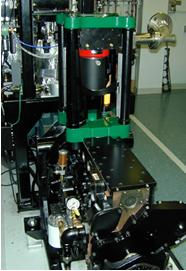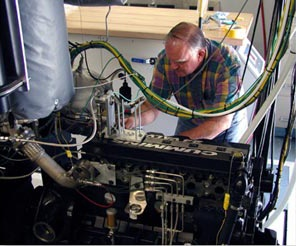Low-temperature gasoline combustion (LTGC) strategies encompass both homogeneous and stratified charge compression ignition (HCCI and SCCI) combustion technologies. These technologies achieve high, diesel-like efficiencies and very low emissions of NOx and particulate. In an LTGC engine, the piston compresses a dilute, premixed fuel/air charge that autoignites and burns volumetrically. The charge is made dilute by either being very lean or by mixing with recycled exhaust gases. By partially stratifying the charge mixture and/or temperature, many technical barriers associated with low-load operation, high HC and CO operation, and excessive pressure rise rates (akin to engine knock) can be overcome.
Figure 1 Optically accessible Low-Temperature Gasoline Combustion (LTGC) engine: The first five cylinders toward the front are deactivated and covered by the black plate. An extended or “Bowditch” piston is installed in the operational cylinder at the back of the engine to provide optical access through a window in the piston top. Optical access is also provided by windows in the red liner segment, one of which is visible.
By partially stratifying the charge mixture and/or temperature, many technical barriers associated with low-load operation, high HC and CO operation, and excessive pressure rise rates (akin to engine knock) can be overcome. The HCCI/SCCI Laboratory provides the science-based understanding required to develop LTGC engines.
The laboratory is equipped with two Cummins B-series production engines, mounted at either end of a double-ended dynamometer, that have been converted for single-cylinder LTGC operation. One engine (the so-called “all-metal engine”) is used to establish operating points, test various fuel types, develop combustion-control strategies, and investigate emissions. The second engine has extensive optical access for the application of advanced laser diagnostics for investigations of in-cylinder processes. The design includes an extended piston with piston-crown window, three large windows near the top of the cylinder wall, and a drop-down cylinder for rapid cleaning of fouled windows.
The engines facilitate a wide range of operating conditions and various fuel-injection, fuel/air/residual mixing, and control strategies for researchers to investigate the potential of overcoming the technical barriers to LTGC. Producing results relevant to both automotive and heavy-duty applications, the 0.98 liters/cylinder engines are equipped with the following features:
- variable in-cylinder swirl: swirl ratios of 0.9 to 3.2, convertible to swirl ratios up to 7.6
- multiple fuel systems: fully premixed, port fuel injection, gasoline-type direct-injection, and diesel-type direct-injection
- complete intake charge conditioning: simulated or real exhaust gas recirculation, intake pressures to 6 atmospheres, and intake temperatures to 220 °C
- speeds up to 3600 rpm (metal engine) and 1800 rpm (optical engine)
- variable compression ratios, currently from 12:1 to 21:1, through interchangeable pistons
- custom HCCI piston design
- full emissions measurements: CO2, CO, O2, HC, NOx, and smoke
Figure 2 A technologist works on the all-metal Low-Temperature Gasoline Combustion (LTGC) engine. As with the optical engine, the first five cylinders (photo, right) are deactivated, and the engine operates as a single cylinder engine, only on cylinder six (photo, left).
Current investigations address several issues, including:
- stratification of the fuel/air mixture as a means of improving emissions and combustion efficiency during part-load operation
- effects of fuel properties on performance and emissions over a range of speeds and loads
- use of biofuels, including ethanol and potential second-generation biofuels, such as iso-pentanol [in cooperation with Sandia bioscience groups and the Joint BioEnergy Institute (JBEI)]
- effects of heat transfer and thermal stratification on LTGC performance and potential for extending operation to higher loads
- intake-pressure boosting and other techniques to extend operation to higher loads and further improve engine efficiency
Because fuel characteristics are central to LTGC engine design, researchers are examining a variety of fuels including gasoline, diesel, biofuels, alternative petroleum-based fuels, and representative constituents of real distillate fuels.

